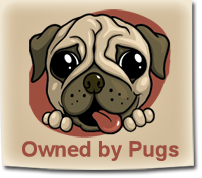The Importance of Training your Pug
By George Cockrell
October 6th, 2004
Young pups of any breed need to learn several things in order to live comfortably with their new owners. Let's start with the basic concept of management. There are three elements that control a dog. They are:
- Containment
- Restraint
- Training
Contain, Restrain, or Train
The more one element is used, it will reduce the need of the other two. Common sense would indicate that the more effective training one accomplishes, the less containment and restraint will be required. Let's look at what each element of management is and how it can be used to provide effective lifetime training.
Containment: That concept is pretty easy. The use of a crate, or securing the dog within some sort of enclosure, prevents the dog from causing any trouble. Unfortunately, using containment only will usually provide the owner with a dog that is frustrated and bored. This can lead to many behavioral problems down the road.
The proper way to use containment, is to use it often while the owner is around and living their daily lives. The dog should be allowed to exercise and get training whenever the dog is out of the crate. Whenever the dog cannot be readily supervised, they should be contained in some secure way. This is exactly what crates were invented for. This approach will expedite housetraining, as well as prevent the unsupervised pup from getting into things and chewing inappropriate items. A pup can't get in too much trouble if he's contained when the owner is unable to provide proper supervision. Dogs are denning animals, so the idea of them staying within an enclosed area is not foreign to them. Some pups may not like the crate, and may fuss a bit. The smart dog owner sees this for what it is, an attempt at manipulation. If one responds to the protest, the pup can essentially train the owner to let him out and praise him to boot. Ignore the pup, they will usually settle down once they realize their protests are falling upon deaf ears.
Next on our list of management tools is Restraint. This concept is simple also. Your puppy cannot cause much trouble if they are restrained with a leash or tie out. Once again, the improper use of restraint may cause unwanted behaviors. Boredom, frustration, and in extreme cases even potential death. We've all heard stories of dogs who were injured or killed by strangulation when left unattended while tied up. I do not tie dogs out, unless they are under my direct supervision. Just holding puppy back when on a leash, is rarely enough to prevent unwanted behavior. One should train the puppy, and save restraint for when it is really needed.
Now, let's look at the final and best solution to any problem that may arise. Training. This concept is the most simple of all. A dog cannot do something wrong, and do something right simultaneously. Jumping up? They can't do that and sit at the same time. Running away? That's impossible if they are coming to you. Barking? Quiet! It's easy to see, that training is the way to go. Clients often comment before we initiate their training, on things like "I don't want to break his spirit" or "I want him to be able to run off lead." The bottom line is, that a trained dog is a dog that enjoys much more freedom and happiness.
If one fails to properly train their dog, the dog must endure things like being choked, because it doesn't know how to walk on a loose lead. An untrained dog quickly becomes an annoyance to people it comes in contact with, and usually ends up sequestered in a crate or another room when guests visit. In my daily rounds, I see people who are constantly yelling at and in some cases even striking their dog, simply because they have not taken the steps necessary to learn good, solid communication and obedience. It seems a shame to me as a dog lover and a professional who knows just how easy teaching and living with dogs can really be.
So, fellow Pug People, which of the three management tools is going to offer the most benefit both owner and dog? The choice is obvious, Training wins hands (or Paws) down.
In future articles, we will address the individual exercises that give freedom to both dog and family.
